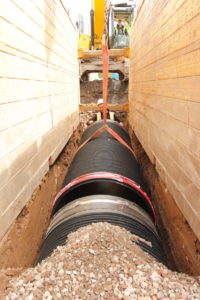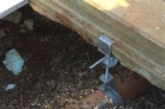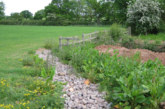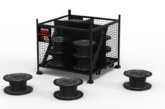
Mark Stanway, Director of Aqua Spira, explains how a development in Cheshire tackled the challenge of stormwater run-off with assistance from Composite Steel Reinforced pipes.
Bollin Park is a housing development in Wilmslow, Cheshire, close to the town centre and to open countryside. The site is being jointly developed by David Wilson Homes and Jones Homes and will eventually accommodate over 200 luxury 4, 5 and 6 bedroom houses.
 In common with all new housing developments, the ever increasing requirement to manage stormwater run-off from the site needed to be addressed. For this particular site, the designers were able to attenuate all of the necessary storage in over-sized pipes within the estate roads, eliminating the need for offline storage tanks, minimizing future maintenance requirements, and perhaps most importantly, ensuring that large areas of valuable land did not need to be set aside to accommodate large underground storage tanks or ponds.
In common with all new housing developments, the ever increasing requirement to manage stormwater run-off from the site needed to be addressed. For this particular site, the designers were able to attenuate all of the necessary storage in over-sized pipes within the estate roads, eliminating the need for offline storage tanks, minimizing future maintenance requirements, and perhaps most importantly, ensuring that large areas of valuable land did not need to be set aside to accommodate large underground storage tanks or ponds.
The stormwater drainage system comprised 700m of 1200mm diameter pipes, and due to the build plan, a significant proportion of the pipes needed to be installed within a very short period of time. Having recently installed several hundred metres of 900mm diameter AquaSpira Composite Steel Reinforced (CSR) pipes on a Taylor Wimpey homes site in Preston, the civil engineering contractor, Westbourne Civil Engineering, had no hesitation in recommending the use the AquaSpira pipes in place of traditional concrete pipes.
Minimising disruption
One of the immediate benefits on site was evident upon arrival of the first loads of pipes. Each load contained 48m of 1200mm pipes, compared to just 15m per load for concrete pipe, resulting in a significant reduction in the total number of deliveries to site from 47 down to just 15, which in terms of minimizing disruption was a significant benefit for all parties.
Once on site, the four packs of pipes per load were safely offloaded in less than 10 minutes with a fork attachment. Pipes were then safely moved around site in their packs, reducing the number of movements by 80%.
Reduction in excavation
One of the main contributing factors to the substantial reduction in programme time was the 30% reduction in excavation due to the much smaller outside diameter of the pipes. The spigot & socket joints, with integral seals and highly recognizable bright red depth insertion marker, enabled the pipes to be quickly and accurately jointed, using the simple, yet innovative Jointing Frame to safely push the pipes home.
Whilst the operational, safety and programme advantages the CSR pipes are clearly evident from sites such as this, the opportunity for developers to achieve a further, and potentially greater step-change in programme and cost reduction is achieved at the design stage.
Due to the reduced outside diameter of CSR pipes, larger diameter pipes can be designed and installed within a smaller footprint. For example, a 1500mm diameter CSR pipe can be installed within the same footprint as a 1200mm diameter concrete pipe, but the storage capacity increases exponentially by over 56% from 1.13m3 to 1.77m3. Larger pipes remain suitably light and efficient to install, so what has been ‘impossible & impractical’ with concrete pipe is now ‘possible & practical’ with CSR pipe, providing an efficient method to tackle stormwater storage.








